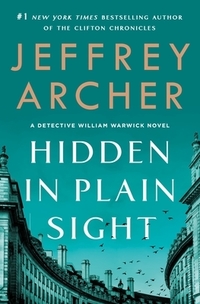Hidden in Plain Sight by Jeffrey Archer
 Wednesday, November 4, 2020 at 7:25AM
Wednesday, November 4, 2020 at 7:25AM 
Published by St. Martin's Press on November 3, 2020
Jeffrey Archer has been chronicling the early career of his fictional creation, William Warwick, who appears later in life in Archer’s Harry Clifton novels. In Nothing Ventured, Archer described Warwick’s efforts to thwart art forgers, a gig he scored by virtue of his degree in art history. Warwick begins Hidden in Plain Sight with a promotion to the rank of Detective Sergeant and reassignment to a new team that is chasing the big dog of London drug smuggling. “The Viper” runs a good chunk of London’s illicit drug market from the top three floors of a building that houses his manufacturing and distribution business. The location, however, is a mystery to the police.
Despite Warwick’s shift to the drug task force, an interesting plot thread continues the art theft plot that drove Nothing Ventured. Miles Faulkner, whose sentence for art fraud was suspended, attempts to foil Warwick’s marriage to Beth. Miles is having marital problems of his own, problems that motivate him to engage in a couple of new crimes to thwart his soon-to-be-ex-wife’s effort to take his house, his art collection, and pretty much everything he owns. By novel’s end, the degree of his success will be in doubt, setting up the continuation of the story in the next novel.
Hidden in Plain Sight takes place in 1986, when it was still considered wise to declare war on drugs rather than treating them as a public health problem. While the drug plot has Warwick playing a significant role in the effort to find the Viper’s den, Warwick learns that his nemesis Faulkner is also involved in drug distribution, at least with regard to his elite friends. Warwick recruits an informant who helps him catch Faulkner with drugs, but whether the evidence will stand up in court leads to a trial that provides another plot point.
The courtroom theatrics are provided by Warwick’s father, representing the Crown, and his sister, who prosecutes as her father’s junior. I always enjoy courtroom scenes and this one is entertaining, in part because a prosecution witness turns out to be unreliable. Still, while discussions of courtroom strategy are always fun, cases turn on evidence and the evidence made the outcome fairly predictable, strategic considerations notwithstanding. As Rumpole sometimes mused, it is easy to prove that guilty person is guilty. Getting a guilty person acquitted is the real courtroom challenge.
My only knock on William Warwick as a character is his stalwart and unblemished nature. Warwick is known as “choirboy” because he is resolutely proper in everything he does. My sense is that Archer means him to be an exemplar of the British upper-crust at their best (Warwick’s father, Sir Julian, is a QC and his sister seems destined to become one). People of resolute moral character, at least in fiction, tend to a bit one-dimensional. All members of the Warwick family dispense bits of trivia so we know they are learned, but it takes more than an ability to explain the origin of “Bob’s your uncle” to give a character a memorable personality. I’d like to see Warwick let his hair down and show us his naughty side, except he doesn’t seem to have one.
Warwick’s moral rectitude does, however, set up a personal conflict (can he remain a police officer if he must serve a corrupt master?) that remains at the end of the novel. Since the Harry Clifton novels answer that question, it isn’t a cliff-hanger, but the novel does set up a (presumably) final conflict between Warwick and Faulkner in the next novel.
On the whole, I enjoyed Hidden in Plain Sight more than Nothing Ventured. There are fewer scenes of Warwick family gatherings that tended to slow the first novel, while the plot moves more quickly and in more directions. Readers who want their crime novel protagonists to be righteous defenders of the law and virtue will likely admire Hidden in Plain Sight.
RECOMMENDED
Reader Comments